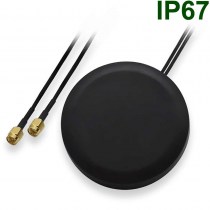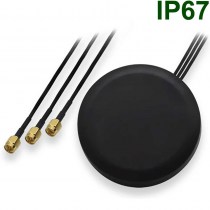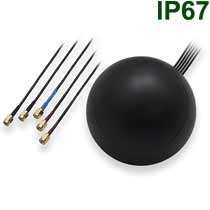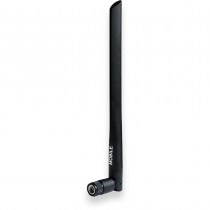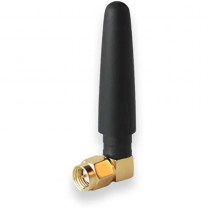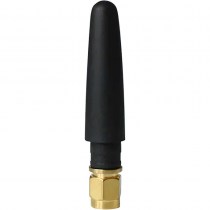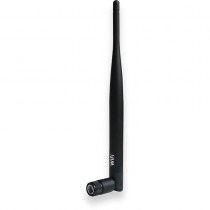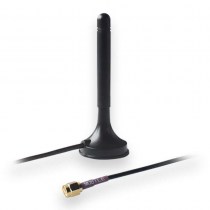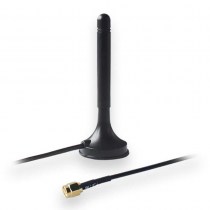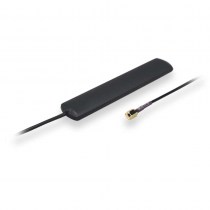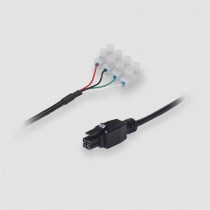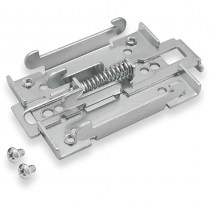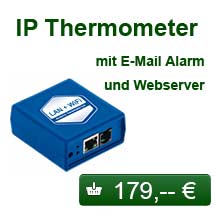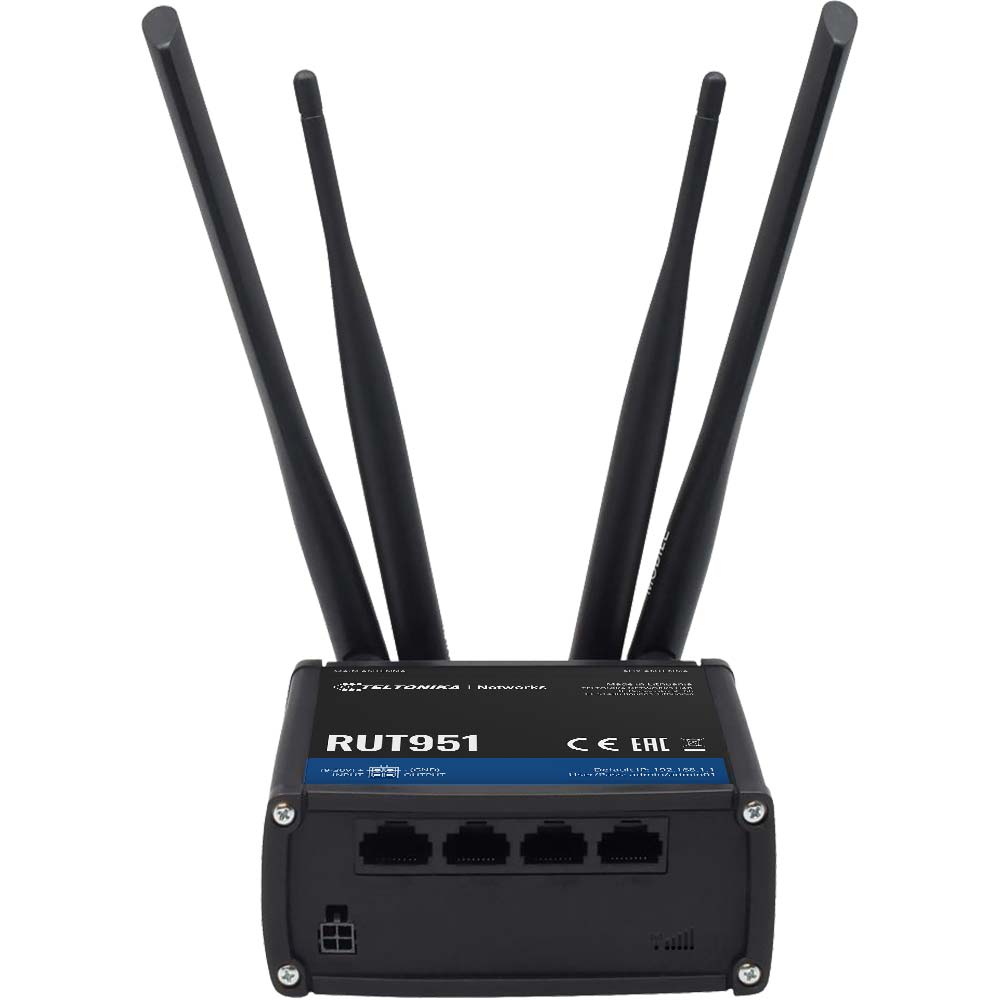








Industrieller LTE Router RUT951 - Dual SIM
Industrierouter/ Industrieller Mobilfunk-Router – 4G/LTE (Kat 4), 3G, 2G
- Dual SIM mit Auto-Failover, Backup-WAN und anderen Switching-Funktionen
- Robustes Aluminium-Gehäuse
- WAN Failover und 4x Ethernet-Schnittstelle mit VLAN-Funktionalität
- Kompakte Größe, einfache Integration
Teltonika RUT951: Industrieller LTE Mobilfunk-Router (Dual-Sim) mit 4x Ethernet Anschlüssen
- Der RUT951 von Teltonika ist die weiterentwickelte Version des Bestsellers Teltonika RUT950, der dessen beste Eigenschaften wie bspw. das industrielle Design, die kompakte Bauweise, die zahlreiche Anschlussschnittstellen und die RMS-Kompatibilität geerbt hat.
- Mit leistungsstarker Mediatek MIPS 24Kc 580 MHz CPU (statt Atheros Wasp, MIPS 74Kc, 550 MHz CPU, wie beim Teltonika RUT950)
Der RUT951 ist ein leistungsstarker industrieller 4G LTE-WLAN-Router aus der Teltonika RUT9**-Serie, der als Haupt- und Backup-Internetzugang konzipiert ist und eine zuverlässige Internetverbindung mit hohem Datendurchsatz und hoher Datenredundanz garantiert.
Dieser Industrial LTE Router kombiniert Dual-SIM 4G-Mobilfunkkonnektivität mit Wi-Fi und 4 Ethernet-Schnittstellen, um die Anforderungen der unterschiedlichsten IoT-Lösungen zu erfüllen.
Das Automatische WAN-Failover auf eine verfügbare Backup-Verbindung gewährleistet eine einzigartige Netzwerkkontinuität und vermeidet Ausfallzeiten.
Powered by RutOS – Dieses Gerät wird mit dem RutOS betrieben, das individuelle Anpassungsmöglichkeiten für den professionellen Einsatz, Automatisierungsfunktionen und ein Höchstmaß an Sicherheit für Ihre Lösung bietet.
Kompatibel mit dem Teltonika Networks Remote Management System (RMS) für einfache und sichere Überwachung und Fernverwaltung.
Teltonika RUT951: Zuverlässiger 4G / LTE Router für private / gewerbliche und industrielle Zwecke
Der Teltonika RUT951 ist ein äußerst zuverlässiger und sicherer LTE Router für private und professionelle Anwendungen. Durch die zwei SIM-Karten Slots (Dual-SIM) und der Failover Funktion bietet der Teltonika RUT951 Router die Möglichkeit eine redundante und ausfallsichere LTE / 4G Verbindung aufzubauen.
150 Mbit Übertragungsraten LTE (Kat 4)
Mit dem LTE Router RUT951 von Teltonika können Sie eine konstante LTE / 4G Internetverbindung errichten. LTE-Übertragungsarten von bis zu 150 MBit im Download und 50 MBit im Upload sowie Download-Geschwindigkeiten von bis zu 42 MBit und Upload-Geschwindigkeiten bis 5,76 MBit im UMTS Betrieb lassen Sie eine performante Anbindungen ans mobilen Datennetz realisieren.
Dual SIM – Zwei SIM-Karten Slots
Der Dual SIM LTE Router RUT951 von Teltonika besitzt 2 SIM-Karten Slots, so dass Sie auch zwei SIM-Karten unterschiedlicher Provider gleichzeitig verwenden können. Dieses bietet für Sie großen Vorteil, dass bei auftretender mangelnder Netzabdeckung eines Providers der Teltonika RUT951 weiterhin über den zweiten Provider mit dem mobilen Datennetz verbunden bleibt, so dass Verbindungsausfälle des Systems vermieden werden.
Nach erfolgter Erst-Konfiguration des LTE Routers RUT951 können Sie sich mit Ihren Endgeräten kabellos per WLAN oder kabelgebunden per LAN über das Mobilfunknetz mit dem Internet verbinden.
Zwei Anschlüsse für externe Antennen (SMA Buchsen)
Über zwei externe LTE Antennenanschlüsse (SMA Buchse) können an den Teltonika RUT951 bei Bedarf leistungsstärkere LTE Antennen angeschlossen und so die LTE Verbindung verstärkt werden.
300 MBit WLAN im 2.4 GHz Band
Der Teltonika RUT951 besitzt einen integrierten 3-Port Ethernet-Switch (10/100MBit), über den Sie Ihre kabelgebundenen Endgeräte an den RUT951 anbinden können. Zudem können Sie mit dem RUT951 – über den integrierten 2.4 GHz WLAN Accesspoint – ein eigenes WLAN mit bis zu 300 MBit aufspannen und sich über dieses komfortabel mit Ihren WLAN Clients verbinden. Damit Ihre Daten immer sicher übertragen werden, unterstützt der RUT951 alle aktuellen Verschlüsselungs- und Sicherheitsmechanismen wie z.B. WPA/ WPA−2.
4G LTE Router mit Fallback Funktion
Dank des WAN-Ports können Sie den 4G LTE Router Teltonika RUT951 auch als DSL Router verwenden, falls kein Mobilfunksignal zur Verfügung stehen sollte. Zudem können Sie den Teltonika RUT951 als WLAN Client betreiben und in einem anderen WLAN Netzwerk anmelden, welches dann als Router fungiert. Bei einem Ausfall einer oder beider LTE Verbindungen kann der Teltonika RUT951 – dank der integrierten Fallback Funktion – automatisch auf eine zuvor definierte DSL Verbindung zurückgreifen.
Einfach Konfiguration über Weboberfläche
Über eine benutzerfreundlichen Weboberfläche lässt sich der LTE Router RUT951 komfortabel konfigurieren.
Spezifkationen des industriellen Dual-SIM LTE Routers RUT951 von Teltonika
| Technische Daten | |
| MOBILE | |
| Mobile module | 4G (LTE) – Cat 4 up to 150 Mbps, 3G – Up to 42 Mbps, 2G – Up to 236.8 kbps |
| SIM switch | 2 SIM cards, auto-switch cases: weak signal, data limit, SMS limit, roaming, no network, network denied, data connection fail, SIM idle protection |
| Status | Signal strength (RSSI), SINR, RSRP, RSRQ, EC/IO, RSCP, Bytes sent/received, connected band, IMSI, ICCID |
| SMS | SMS status, SMS configuration, send/read SMS via HTTP POST/GET, EMAIL to SMS, SMS to EMAIL, SMS to HTTP, SMS to SMS, scheduled SMS, SMS autoreply, SMPP |
| Black/White list | Operator black/white list |
| Band management | Band lock, Used band status display |
| APN | Auto APN |
| Bridge | Direct connection (bridge) between mobile ISP and device on LAN |
| Passthrough | Router assigns its mobile WAN IP address to another device on LAN |
| Multiple PDN (optional) | Possibility to use different PDNs for multiple network access and services (not available in standard FW) |
| WIRELESS | |
| Wireless mode | IEEE 802.11b/g/n, Access Point (AP), Station (STA) |
| WiFi security | WPA2-Enterprise - PEAP, WPA2-PSK, WEP, WPA-EAP, WPA-PSK; AES-CCMP, TKIP, Auto Cipher modes, client separation |
| SSID | SSID stealth mode and access control based on MAC address |
| WiFi users | Up to 100 simultaneous connections |
| Wireless Hotspot | Captive portal (Hotspot), internal/external Radius server, built in customizable landing page |
| ETHERNET | |
| WAN | 1 x WAN port (can be configured to LAN) 10/100 Mbps, compliance IEEE 802.3, IEEE 802.3u standards, supports auto MDI/MDIX |
| LAN | 3 x LAN ports, 10/100 Mbps, compliance IEEE 802.3, IEEE 802.3u standards, supports auto MDI/MDIX |
| NETWORK | |
| Routing | Static routing, Dynamic routing (BGP, OSPF v2, RIP v1/v2, NHRP) |
| Network protocols | TCP, UDP, IPv4, IPv6, ICMP, NTP, DNS, HTTP, HTTPS, FTP, SMTP, SSL v3, TLS, ARP, VRRP, PPP, PPPoE, UPNP, SSH, DHCP, Telnet, SMPP, SMNP, MQTT, Wake On Lan (WOL) |
| VoIP passthrough support | H.323 and SIP-alg protocol NAT helpers, allowing proper routing of VoIP packets |
| Connection monitoring | Ping Reboot, Wget Reboot, Periodic Reboot, LCP and ICMP for link inspection |
| Firewall | Port forward, traffic rules, custom rules |
| DHCP | Static and dynamic IP allocation, DHCP Relay, Relayd |
| QoS / Smart Queue Management (SQM) | Traffic priority queuing by source/destination, service, protocol or port, WMM, 802.11e |
| DDNS | Supported >25 service providers, others can be configured manually |
| Network backup | VRRP, Mobile, Wired and WiFi WAN options, each of which can be used as backup, using automatic Failover |
| Load balancing | Balance your internet traffic over multiple WAN connections |
| SSHFS (optional) | Possibility to mount remote file system via SSH protocol (not available in standard FW) |
| SECURITY | |
| Authentication | Pre-shared key, digital certificates, X.509 certificates |
| Firewall | Pre-configured firewall rules can be enabled via web-ui, unlimited firewall configuration via CLI; DMZ; NAT; NAT-T |
| Attack prevention | DDOS prevention (SYN flood protection, SSH attack prevention, HTTP/HTTPS attack prevention), port scan prevention ( SYN-FIN, SYN-RST, X-mas, NULL flags, FIN scan attacks) |
| VLAN | Port and tag based VLAN separation |
| Mobile quota control | Set up custom data limits for both SIM cards |
| WEB filter | Blacklist for blocking out unwanted websites, whitelist for specifying allowed sites only |
| Access control | Flexible access control of TCP, UDP, ICMP packets, MAC address filter |
| Secure Boot | Cryptographic integrity check of the each system boot process (available on device with special order code RUT950U072C0). |
| VPN | |
| OpenVPN | Multiple clients and server can be running simultaneously, 12 encryption methods |
| OpenVPN Encryption | DES-CBC, RC2-CBC, DES-EDE-CBC, DES-EDE3-CBC, DESX-CBC, BF-CBC, RC2-40-CBC, CAST5-CBC, RC2-64-CBC, AES-128-CBC, AES-192-CBC, AES-256-CBC |
| IPsec | IKEv1, IKEv2, supports up to 4 x VPN IPsec tunnels (instances), with 5 encryption methods (DES, 3DES, AES128, AES192, AES256) |
| GRE | GRE tunnel |
| PPTP, L2TP | Client/Server services can run simultaneously |
| Stunnel | Proxy designed to add TLS encryption functionality to existing clients and servers without any changes in the programs' code |
| DMVPN | Method of building scalable IPsec VPNs |
| SSTP | SSTP client instance support |
| ZeroTier | ZeroTier VPN |
| WireGuard | WireGuard VPN client and server support |
| MODBUS TCP SLAVE | |
| ID range | Respond to one ID in range [1;255] or any |
| Allow Remote Access | Allow access through WAN |
| Custom registers | MODBUS TCP custom register block requests, which read/write to a file inside the router, and can be used to extend MODBUS TCP Slave functionality |
| MODBUS TCP MASTER | |
| Supported functions | 01, 02, 03, 04, 05, 06, 15, 16 |
| Supported data formats | 8 bit: INT, UINT; 16 bit: INT, UINT (MSB or LSB first); 32 bit: float, INT, UINT (ABCD (big-endian), DCBA (little-endian), CDAB, BADC) |
| MODBUS DATA TO SERVER | |
| Protocol | HTTP(S), MQTT, Azure MQTT |
| MQTT GATEWAY | |
| MQTT gateway | Allows sending commands and receiving data from MODBUS Master through MQTT broker |
| DNP3 | |
| Supported modes | TCP Master, DNP3 Outstation |
| MONITORING & MANAGEMENT | |
| WEB UI | HTTP/HTTPS, status, configuration, FW update, CLI, troubleshoot, event log, system log, kernel log |
| FOTA | Firmware update from server, automatic notification |
| SSH | SSH (v1, v2) |
| SMS | SMS status, SMS configuration, send/read SMS via HTTP POST/GET |
| Call | Reboot, Status, WiFi on/off, Mobile data on/off, Output on/off |
| TR-069 | OpenACS, EasyCwmp, ACSLite, tGem, LibreACS, GenieACS, FreeACS, LibCWMP, Friendly tech, AVSystem |
| MQTT | MQTT Broker, MQTT publisher |
| SNMP | SNMP (v1, v2, v3), SNMP trap |
| JSON-RPC | Management API over HTTP/HTTPS |
| MODBUS | MODBUS TCP status/control |
| RMS | Teltonika Remote Management System (RMS) |
| IoT PLATFORMS | |
| Cloud of Things | Allows monitoring of: Device data, Mobile data, Network info, Availability |
| ThingWorx | Allows monitoring of: WAN Type, WAN IP Mobile Operator Name, Mobile Signal Strength, Mobile Network Type |
| Cumulocity | Allows monitoring of: Device Model, Revision and Serial Number, Mobile Cell ID, ICCID, IMEI, Connection Type, Operator, Signal Strength, WAN Type and IP |
| Azure IoT Hub | Can send device IP, Number of bytes send/received/ 3G connection state, Network link state, IMEI, ICCID, Model, Manufacturer, Serial, Revision, IMSI, Sim State, PIN state, GSM signal, WCDMA RSCP WCDMA EC/IO, LTE RSRP, LTE SINR, LTE RSRQ, CELL ID, Operator, Operator number, Connection type, Temperature, PIN count to Azure IoT Hub server |
| SYSTEM CHARACTERISTICS | |
| CPU | Mediatek MIPS 24Kc 580 MHz |
| RAM | 128 MB, DDR2 |
| FLASH storage | 16 MB, SPI Flash |
| FIRMWARE / CONFIGURATION | |
| WEB UI | Update FW from file, check FW on server, configuration profiles, configuration backup, restore point |
| FOTA | Update FW/configuration from server |
| RMS | Update FW/configuration for multiple devices |
| Keep settings | Update FW without losing current configuration |
| FIRMWARE CUSTOMIZATION | |
| Operating system | RutOS (OpenWrt based Linux OS) |
| Supported languages | Busybox shell, Lua, C, C++ |
| Development tools | SDK package with build environment provided |
| INPUT/OUTPUT | |
| Input | 1 x Digital input, 0 - 6 V detected as logic low, 8 - 30 V detected as logic high |
| Output | 1 x Digital open collector output, max output 30 V, 300 mA |
| Events | SMS, EMAIL, RMS |
| POWER | |
| Connector | 4 pin industrial DC power socket |
| Input voltage range | 9 – 30 VDC, reverse polarity protection; surge protection >31VDC 10us max |
| PoE (passive) | Passive PoE over spare pairs. Possibility to power up through LAN port, not compatible with IEEE802.3af, 802.3at and 802.3bt standards |
| Power consumption | < 2 W idle, < 7 W Max |
| PHYSICAL INTERFACES (PORTS, LEDS, ANTENNAS, BUTTONS, SIM) | |
| Ethernet | 4 x RJ45 ports, 10/100 Mbps |
| I/O’s | 1 x Digital Input, 1 x Digital Output on 4 pin power connector (available from HW revision 1600) |
| Status LEDs | 1 x bi-color connection status LED, 5 x connection strength LEDs, 4 x LAN status LEDs, 1 x Power LED |
| SIM | 2 x SIM slots (Mini SIM - 2FF), 1.8 V/3 V, external SIM holders, eSIM (Optional) |
| Power | 1 x 4 pin power connector |
| Antennas | 2 x SMA for LTE, 2 x RP-SMA for WiFi antenna connectors |
| Reset | Reboot/User default reset/Factory reset button |
| PHYSICAL SPECIFICATION | |
| Casing material | Aluminium housing, plastic panels |
| Dimensions (WxHxD) | 110 x 50 x 100 mm |
| Weight | 287 g |
| Mounting options | DIN rail (can be mounted on two sides), flat surface placement |
| OPERATING ENVIRONMENT | |
| Operating temperature | -40 °C to 75 °C |
| Operating humidity | 10% to 90% non-condensing |
| Ingress Protection Rating | IP30 |
| REGULATORY & TYPE APPROVALS | |
| Regulatory | CE/RED, UKCA, CB |
| EMI IMMUNITY | |
| Standards | EN 301 489-1 V2.2.3, EN 301 489-17 V3.2.4, Final draft EN 301 489-52 V1.2.0, EN 55032:2015+A1:2020, EN 55035:2017+A11:2020, EN 61000-3-3:2013+A1:2019, EN IEC 61000-3-2:2019 |
| ESD | EN61000-4-2:2009 |
| Radiated Immunity | EN 61000-4-3:2020 |
| EFT | EN 61000-4-4:2012 |
| Surge immunity (AC Mains Power Line) | EN 61000-4-5:2014+A1:2017 |
| CS | EN 61000-4-6:2014 |
| DIP | EN 61000-4-11:2020 |
| RF | |
| Standards | EN 300 328 V2.2.2, EN 301 908-1 V13.1.1, EN 301 908-2 V13.1.1, EN 301 908-13 V13.1.1 |
| SAFETY | |
| Standards | IEC 60950-1:2005 (Second Edition) + Am 1:2009 + Am 2:2013 AS/NZS 60950.1:2015 EN 50665:2017, EN 62311:2008 FCC 47 CFR Part 1 1.1310 |
| ENVIRONMENTAL | |
| Ingress Protect | EN IEC 62311:2020 IEC 62368-1:2018 EN IEC 62368-1:2020+A11:2020 |
Lieferumfang des CAT4 LTE Routers RUT951 von Teltonika
- 1x Teltonika RUT951: Dual-SIM LTE / 4G Router
- 2x LTE-Antennen (schwenkbar/ drehbar, SMA-Stecker)
- 2x WiFi-Antenne (schwenkbar/ drehbar, RP-SMA-Stecker)
- 1x Ethernet-Kabel (1,5m)
- 1x Teltonika PR3PUEU3: 9V/1A EU Steckernetzteil (9W)
- SIM-Adapter-Kit
- 1x Kurzanleitung/ Schnellstartanleitung [Quick Start Guide] (englisch)
Empfohlenes Zubehör
Kundenrezensionen
Spezifkationen des industriellen Dual-SIM LTE Routers RUT951 von Teltonika
| Technische Daten | |
| MOBILE | |
| Mobile module | 4G (LTE) – Cat 4 up to 150 Mbps, 3G – Up to 42 Mbps, 2G – Up to 236.8 kbps |
| SIM switch | 2 SIM cards, auto-switch cases: weak signal, data limit, SMS limit, roaming, no network, network denied, data connection fail, SIM idle protection |
| Status | Signal strength (RSSI), SINR, RSRP, RSRQ, EC/IO, RSCP, Bytes sent/received, connected band, IMSI, ICCID |
| SMS | SMS status, SMS configuration, send/read SMS via HTTP POST/GET, EMAIL to SMS, SMS to EMAIL, SMS to HTTP, SMS to SMS, scheduled SMS, SMS autoreply, SMPP |
| Black/White list | Operator black/white list |
| Band management | Band lock, Used band status display |
| APN | Auto APN |
| Bridge | Direct connection (bridge) between mobile ISP and device on LAN |
| Passthrough | Router assigns its mobile WAN IP address to another device on LAN |
| Multiple PDN (optional) | Possibility to use different PDNs for multiple network access and services (not available in standard FW) |
| WIRELESS | |
| Wireless mode | IEEE 802.11b/g/n, Access Point (AP), Station (STA) |
| WiFi security | WPA2-Enterprise - PEAP, WPA2-PSK, WEP, WPA-EAP, WPA-PSK; AES-CCMP, TKIP, Auto Cipher modes, client separation |
| SSID | SSID stealth mode and access control based on MAC address |
| WiFi users | Up to 100 simultaneous connections |
| Wireless Hotspot | Captive portal (Hotspot), internal/external Radius server, built in customizable landing page |
| ETHERNET | |
| WAN | 1 x WAN port (can be configured to LAN) 10/100 Mbps, compliance IEEE 802.3, IEEE 802.3u standards, supports auto MDI/MDIX |
| LAN | 3 x LAN ports, 10/100 Mbps, compliance IEEE 802.3, IEEE 802.3u standards, supports auto MDI/MDIX |
| NETWORK | |
| Routing | Static routing, Dynamic routing (BGP, OSPF v2, RIP v1/v2, NHRP) |
| Network protocols | TCP, UDP, IPv4, IPv6, ICMP, NTP, DNS, HTTP, HTTPS, FTP, SMTP, SSL v3, TLS, ARP, VRRP, PPP, PPPoE, UPNP, SSH, DHCP, Telnet, SMPP, SMNP, MQTT, Wake On Lan (WOL) |
| VoIP passthrough support | H.323 and SIP-alg protocol NAT helpers, allowing proper routing of VoIP packets |
| Connection monitoring | Ping Reboot, Wget Reboot, Periodic Reboot, LCP and ICMP for link inspection |
| Firewall | Port forward, traffic rules, custom rules |
| DHCP | Static and dynamic IP allocation, DHCP Relay, Relayd |
| QoS / Smart Queue Management (SQM) | Traffic priority queuing by source/destination, service, protocol or port, WMM, 802.11e |
| DDNS | Supported >25 service providers, others can be configured manually |
| Network backup | VRRP, Mobile, Wired and WiFi WAN options, each of which can be used as backup, using automatic Failover |
| Load balancing | Balance your internet traffic over multiple WAN connections |
| SSHFS (optional) | Possibility to mount remote file system via SSH protocol (not available in standard FW) |
| SECURITY | |
| Authentication | Pre-shared key, digital certificates, X.509 certificates |
| Firewall | Pre-configured firewall rules can be enabled via web-ui, unlimited firewall configuration via CLI; DMZ; NAT; NAT-T |
| Attack prevention | DDOS prevention (SYN flood protection, SSH attack prevention, HTTP/HTTPS attack prevention), port scan prevention ( SYN-FIN, SYN-RST, X-mas, NULL flags, FIN scan attacks) |
| VLAN | Port and tag based VLAN separation |
| Mobile quota control | Set up custom data limits for both SIM cards |
| WEB filter | Blacklist for blocking out unwanted websites, whitelist for specifying allowed sites only |
| Access control | Flexible access control of TCP, UDP, ICMP packets, MAC address filter |
| Secure Boot | Cryptographic integrity check of the each system boot process (available on device with special order code RUT950U072C0). |
| VPN | |
| OpenVPN | Multiple clients and server can be running simultaneously, 12 encryption methods |
| OpenVPN Encryption | DES-CBC, RC2-CBC, DES-EDE-CBC, DES-EDE3-CBC, DESX-CBC, BF-CBC, RC2-40-CBC, CAST5-CBC, RC2-64-CBC, AES-128-CBC, AES-192-CBC, AES-256-CBC |
| IPsec | IKEv1, IKEv2, supports up to 4 x VPN IPsec tunnels (instances), with 5 encryption methods (DES, 3DES, AES128, AES192, AES256) |
| GRE | GRE tunnel |
| PPTP, L2TP | Client/Server services can run simultaneously |
| Stunnel | Proxy designed to add TLS encryption functionality to existing clients and servers without any changes in the programs' code |
| DMVPN | Method of building scalable IPsec VPNs |
| SSTP | SSTP client instance support |
| ZeroTier | ZeroTier VPN |
| WireGuard | WireGuard VPN client and server support |
| MODBUS TCP SLAVE | |
| ID range | Respond to one ID in range [1;255] or any |
| Allow Remote Access | Allow access through WAN |
| Custom registers | MODBUS TCP custom register block requests, which read/write to a file inside the router, and can be used to extend MODBUS TCP Slave functionality |
| MODBUS TCP MASTER | |
| Supported functions | 01, 02, 03, 04, 05, 06, 15, 16 |
| Supported data formats | 8 bit: INT, UINT; 16 bit: INT, UINT (MSB or LSB first); 32 bit: float, INT, UINT (ABCD (big-endian), DCBA (little-endian), CDAB, BADC) |
| MODBUS DATA TO SERVER | |
| Protocol | HTTP(S), MQTT, Azure MQTT |
| MQTT GATEWAY | |
| MQTT gateway | Allows sending commands and receiving data from MODBUS Master through MQTT broker |
| DNP3 | |
| Supported modes | TCP Master, DNP3 Outstation |
| MONITORING & MANAGEMENT | |
| WEB UI | HTTP/HTTPS, status, configuration, FW update, CLI, troubleshoot, event log, system log, kernel log |
| FOTA | Firmware update from server, automatic notification |
| SSH | SSH (v1, v2) |
| SMS | SMS status, SMS configuration, send/read SMS via HTTP POST/GET |
| Call | Reboot, Status, WiFi on/off, Mobile data on/off, Output on/off |
| TR-069 | OpenACS, EasyCwmp, ACSLite, tGem, LibreACS, GenieACS, FreeACS, LibCWMP, Friendly tech, AVSystem |
| MQTT | MQTT Broker, MQTT publisher |
| SNMP | SNMP (v1, v2, v3), SNMP trap |
| JSON-RPC | Management API over HTTP/HTTPS |
| MODBUS | MODBUS TCP status/control |
| RMS | Teltonika Remote Management System (RMS) |
| IoT PLATFORMS | |
| Cloud of Things | Allows monitoring of: Device data, Mobile data, Network info, Availability |
| ThingWorx | Allows monitoring of: WAN Type, WAN IP Mobile Operator Name, Mobile Signal Strength, Mobile Network Type |
| Cumulocity | Allows monitoring of: Device Model, Revision and Serial Number, Mobile Cell ID, ICCID, IMEI, Connection Type, Operator, Signal Strength, WAN Type and IP |
| Azure IoT Hub | Can send device IP, Number of bytes send/received/ 3G connection state, Network link state, IMEI, ICCID, Model, Manufacturer, Serial, Revision, IMSI, Sim State, PIN state, GSM signal, WCDMA RSCP WCDMA EC/IO, LTE RSRP, LTE SINR, LTE RSRQ, CELL ID, Operator, Operator number, Connection type, Temperature, PIN count to Azure IoT Hub server |
| SYSTEM CHARACTERISTICS | |
| CPU | Mediatek MIPS 24Kc 580 MHz |
| RAM | 128 MB, DDR2 |
| FLASH storage | 16 MB, SPI Flash |
| FIRMWARE / CONFIGURATION | |
| WEB UI | Update FW from file, check FW on server, configuration profiles, configuration backup, restore point |
| FOTA | Update FW/configuration from server |
| RMS | Update FW/configuration for multiple devices |
| Keep settings | Update FW without losing current configuration |
| FIRMWARE CUSTOMIZATION | |
| Operating system | RutOS (OpenWrt based Linux OS) |
| Supported languages | Busybox shell, Lua, C, C++ |
| Development tools | SDK package with build environment provided |
| INPUT/OUTPUT | |
| Input | 1 x Digital input, 0 - 6 V detected as logic low, 8 - 30 V detected as logic high |
| Output | 1 x Digital open collector output, max output 30 V, 300 mA |
| Events | SMS, EMAIL, RMS |
| POWER | |
| Connector | 4 pin industrial DC power socket |
| Input voltage range | 9 – 30 VDC, reverse polarity protection; surge protection >31VDC 10us max |
| PoE (passive) | Passive PoE over spare pairs. Possibility to power up through LAN port, not compatible with IEEE802.3af, 802.3at and 802.3bt standards |
| Power consumption | < 2 W idle, < 7 W Max |
| PHYSICAL INTERFACES (PORTS, LEDS, ANTENNAS, BUTTONS, SIM) | |
| Ethernet | 4 x RJ45 ports, 10/100 Mbps |
| I/O’s | 1 x Digital Input, 1 x Digital Output on 4 pin power connector (available from HW revision 1600) |
| Status LEDs | 1 x bi-color connection status LED, 5 x connection strength LEDs, 4 x LAN status LEDs, 1 x Power LED |
| SIM | 2 x SIM slots (Mini SIM - 2FF), 1.8 V/3 V, external SIM holders, eSIM (Optional) |
| Power | 1 x 4 pin power connector |
| Antennas | 2 x SMA for LTE, 2 x RP-SMA for WiFi antenna connectors |
| Reset | Reboot/User default reset/Factory reset button |
| PHYSICAL SPECIFICATION | |
| Casing material | Aluminium housing, plastic panels |
| Dimensions (WxHxD) | 110 x 50 x 100 mm |
| Weight | 287 g |
| Mounting options | DIN rail (can be mounted on two sides), flat surface placement |
| OPERATING ENVIRONMENT | |
| Operating temperature | -40 °C to 75 °C |
| Operating humidity | 10% to 90% non-condensing |
| Ingress Protection Rating | IP30 |
| REGULATORY & TYPE APPROVALS | |
| Regulatory | CE/RED, UKCA, CB |
| EMI IMMUNITY | |
| Standards | EN 301 489-1 V2.2.3, EN 301 489-17 V3.2.4, Final draft EN 301 489-52 V1.2.0, EN 55032:2015+A1:2020, EN 55035:2017+A11:2020, EN 61000-3-3:2013+A1:2019, EN IEC 61000-3-2:2019 |
| ESD | EN61000-4-2:2009 |
| Radiated Immunity | EN 61000-4-3:2020 |
| EFT | EN 61000-4-4:2012 |
| Surge immunity (AC Mains Power Line) | EN 61000-4-5:2014+A1:2017 |
| CS | EN 61000-4-6:2014 |
| DIP | EN 61000-4-11:2020 |
| RF | |
| Standards | EN 300 328 V2.2.2, EN 301 908-1 V13.1.1, EN 301 908-2 V13.1.1, EN 301 908-13 V13.1.1 |
| SAFETY | |
| Standards | IEC 60950-1:2005 (Second Edition) + Am 1:2009 + Am 2:2013 AS/NZS 60950.1:2015 EN 50665:2017, EN 62311:2008 FCC 47 CFR Part 1 1.1310 |
| ENVIRONMENTAL | |
| Ingress Protect | EN IEC 62311:2020 IEC 62368-1:2018 EN IEC 62368-1:2020+A11:2020 |
Lieferumfang des CAT4 LTE Routers RUT951 von Teltonika
- 1x Teltonika RUT951: Dual-SIM LTE / 4G Router
- 2x LTE-Antennen (schwenkbar/ drehbar, SMA-Stecker)
- 2x WiFi-Antenne (schwenkbar/ drehbar, RP-SMA-Stecker)
- 1x Ethernet-Kabel (1,5m)
- 1x Teltonika PR3PUEU3: 9V/1A EU Steckernetzteil (9W)
- SIM-Adapter-Kit
- 1x Kurzanleitung/ Schnellstartanleitung [Quick Start Guide] (englisch)



